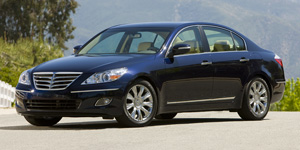
NEW YORK – Hyundai Motor America President and CEO John Krafcik imagines a day when the Genesis luxury sedan and upcoming coupe grow from nameplates to a bonafide brand.
“It would be like Lexus,” Krafcik tells a small group of journalists here.
Toyota Motor Corp. introduced the Lexus brand in the U.S. 20 years ago with the LS 400 and ES 250, adding the ES 300 sedan and SC 400 coupe two years later. The Lexus lineup has grown to eight nameplates today.
Although Krafcik says he hopes for the same success for a Genesis brand, he notes Hyundai does not intend to set up separate stores as their Japanese competitors did right out of the gate in 1989.
“That would be the most expensive way to go,” he says. Hyundai Motor Co. Ltd. officials in South Korea told Ward’s last year creating a separate luxury channel could cost upwards of $2.5 billion.
Instead, Krafcik would like to see a lineup of Genesis models within existing Hyundai dealerships but sectioned off in their own area. He calls it a reverse on the Scion strategy, where Toyota co-locates its youth-oriented brand in Toyota dealerships, or similar to Mercedes-Benz selling its ultra-luxury Maybach models in its stores. “That’s a good way to go,” Krafcik says. “That way, dealers don’t have to spend $5 million, $10 million on a new luxury brand. Sectioning off the brand, that’s the Holy Grail.”
Five years ago, Hyundai expected its U.S. subsidiary to grow sales to 500,000 units a year by 2006 and deliver 1 million vehicles annually by 2010. But the brand has yet to reach 500,000 sales a year, delivering 401,742 vehicles in 2008, Ward’s data shows.

The shortfall has come with consequences. Krafcik was installed as head of the U.S. sales arm last year, replacing Jong Eun Kim, who returned to Korea after supplanting Robert Cosmai and Steve Wilhite. Neither Cosmai nor Wilhite lasted even two years, rumored to have been dismissed for failing to meet Hyundai’s U.S. sales targets.
Krafcik, who came to Hyundai in 2004 after 14 years at Ford Motor Co. and was the first American engineer at the New United Motor Mfg. Inc. joint-venture plant of Toyota and General Motors Corp., says it would be unfair to characterize executives in Seoul as unrealistic.
“There is a tremendous amount of impatience and a desire to do more,” he admits. “But I’ve never been given a target I didn’t know how to deliver on. At Toyota and Ford, I’d be given a goal, and I remember thinking, ‘Is that all?’”
In that sense, Krafcik says Hyundai compares well with Volkswagen AG, which expects to grow sales in the U.S. to 800,000 units annually by 2018. Last year, VW and its Audi luxury-brand division sold a combined 310,888 units, compared with 324,080 in like-2007, according to Ward’s data. VW-brand sales accounted for 223,127 units in 2008 and 230,572 in 2007.

“There is an incredible ambition and drive at Volkswagen,” Krafcik says, adding both the Hyundai and Volkswagen cultures would be more likely to forgive missing a cost target than a functional bogey.
Krafcik says despite Hyundai’s momentum in the marketplace – he jokes that in terms of year-over-year sales “flat results” are now a reason to cheer – the auto maker has lost “a few” of its 790 dealers. The $200 billion Term Asset-Backed Securities Loan Facility rolled out last month and meant to provide dealers with financing for their customers and floorplanning for their facilities hasn’t helped.
“It went right over our dealers,” says Krafcik, who estimates as many as 40 more Hyundai dealers could fold from the recession.
On the powertrain front, Krafcik says Hyundai will introduce direct injection and turbocharging with 4-cyl.engine models of the redesigned Sonata coming next year.
With Hyundai’s U.S. fleet now averaging 28 to 29 mpg (8.4-8.1 L/100 km), Krafcik doesn’t expect any problems achieving upcoming corporate average fuel economy increases. But the auto maker’s engine portfolio will be “hugely biased” towards 4-cyl. engines by 2015, he notes.
And while electrification will play a role at the auto maker in the coming years, Hyundai has no plans to introduce models powered by a diesel engine as some other overseas-based auto makers selling in the U.S. intend.
Krafcik praises GM and Ford for following Hyundai’s lead by introducing vehicle buy-back plans similar to the Hyundai Assurance Program.
“I’m glad GM and Ford did that,” he says. “It’s good for the industry overall because it helps get people into the showrooms.”
Krafcik says he thinks it may have irked Ford and GM executives to follow the much smaller Hyundai to market with the scheme. “I think it bugged them.”
Under Hyundai Assurance, the auto maker provisionally will buy back its vehicles if owners lose their jobs within 12 months of purchase. The plan has spurred sales by removing fear prevalent in today’s uncertain economy, Krafcik says.
Hyundai hasn’t repurchased any vehicles since the program started Jan. 3. Krafcik acknowledges earlier misspeaking when he said two vehicles were bought back. “It turns out, it was just two inquiries.”
– with Steve Finlay



